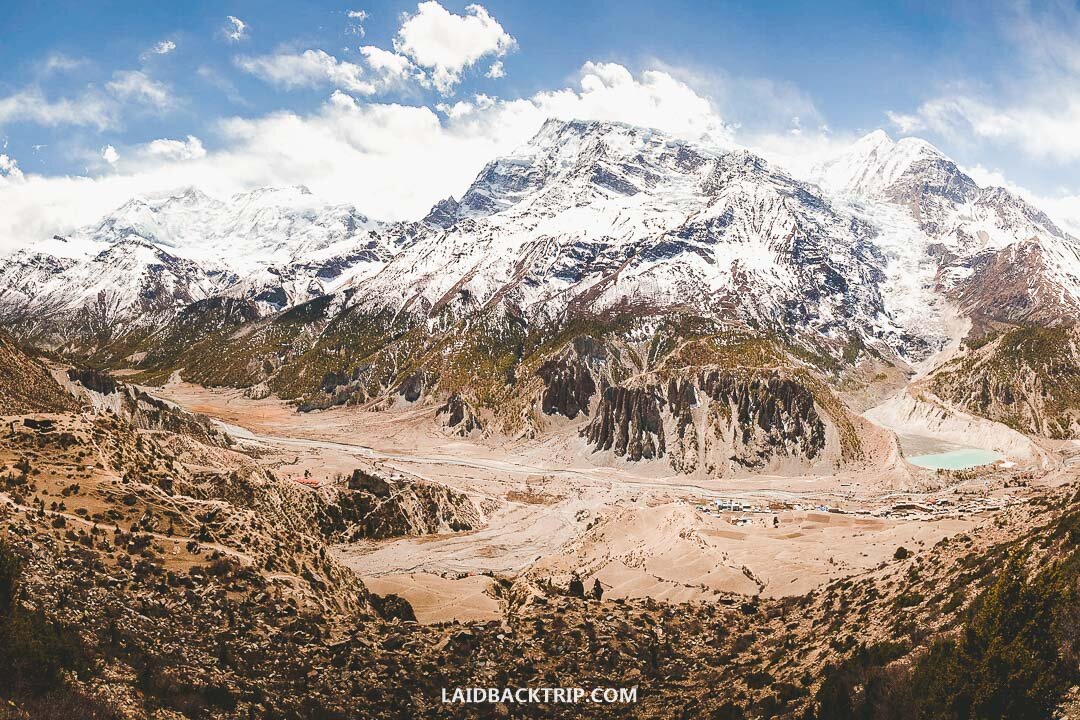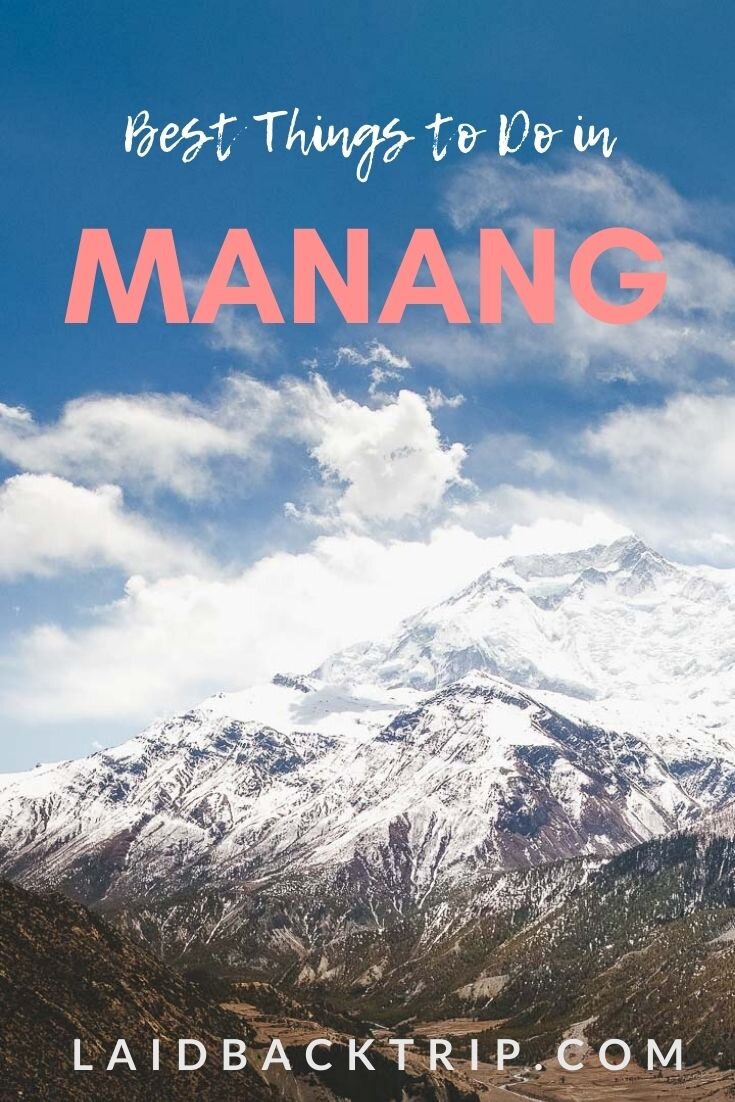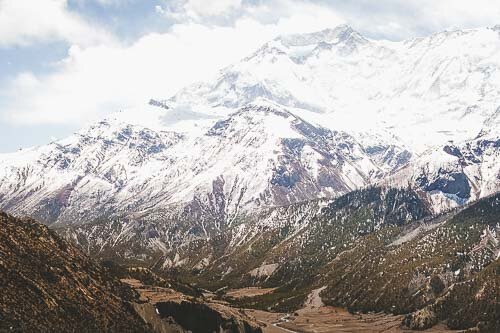Things to Do in Manang, Nepal
Manang is a classic stop on the Annapurna Circuit Trek, as this Nepali village high in the Himalayas is a perfect place for acclimatization. This travel guide features the best things to do in Manang, top day trips, and practical information.
At 3519 meters above sea level, Manang is a crucial point on the Annapurna Circuit itinerary for many hikers. This village and the area around is home to approximately 7000 people, and it offers travelers welcoming change because wandering Himalayas is mostly about staying in remote and simple settlements.
Do not expect luxury and take this information with grain of salt, but the fact that Manang is connected with the outside world by road means that you can find here well-stocked grocery shops, stores with outdoor equipment, and even an ATM or cinema.
Except for these perks, Manang is also a destination worth spending some time because of the acclimatization.
The thinner air affects every traveler differently; some people can feel out of breath above the line of 2500 meters, but it is usually Manang when it comes to the crunch.
From now on, you should not climb more than 400-600 meters per day, and you should always sleep lower than was the highest point on the trail that day - proper acclimatization is the only way that will increase your chance to cross Thorong La Pass, the highest point on the loop.
Luckily, Manang is exactly the place where you can prepare your mind and body for the most challenging part of the Annapurna Circuit Trek, but what's more important, you'll be getting ready in one of the most beautiful landscapes in the mountains.
Manang is surrounded by steeps slopes, 7000 or 8000 meters high snow-covered peaks, and glacial lakes. Do not take the necessity of staying in Manang as a disadvantage.
The scenery is out of the world, and in this blog post, we want to share with you tips on the best things to do in Manang so that you can plan your time in the village.
BEST THINGS TO DO IN MANANG
Manang is all about views and one-day trips, but on the other hand, some of the best things to do will take you back to civilization.
When planning the trek's itinerary, always keep in mind that the weather in the mountains is unpredictable, and you will also need extra days for acclimatization.
We spent in Manang area three nights and two full days, but the number of top activities could keep us busy for much longer.
Another thing you can enjoy in Manang is the atmosphere. You can feel the excitement in the air. Hikers are getting closer to Thorong La Pass, and it is cool to be in a place with so many same-minded people around.
So what can you do in Manang? From actively spent days to lazing around, here's an option for everyone.
ACCLIMATIZATION
We've said that before and would repeat it again. Manang is a great destination to recover, gather strength, and prepare your body before continuing to the higher elevation.
By no means do not underestimate the importance of acclimatization.
The good thing is that you do not have to do anything if you do not want to. Even though we are convinced that it is worth it to make at least a one-day trip to the higher elevation, the simple existence at such an altitude has a favorable outcome.
Walk around Manang, breathe the fresh air, and get yourself ready for the last push across the pass at 5416 meters.
To acclimatize well, do not drink alcohol, but stay hydrated and drink a lot of water.
As tap water is not drinkable in Nepal, in order to lower your plastic consumption, consider before your trip to buy a reusable water bottle (and refill in drinking stations along the way) or SteriPen that sterilize the clear water straight away.
PRAKEN GOMPA
One of the most popular things to do in Manang is the relatively short climb to Praken Gompa. This small religious building hidden in the mountain wall lies at 3945 meters, and the spot offers wonderful views of the village in the valley.
Still, when the weather is pleasant, you will also see Annapurna IV, Annapurna II, Gangapurna, and Tarke Kang.
We did not find this hike that demanding at the time of the activity, but we were pretty worn down later in the afternoon as the elevation and exhaustion from the previous days took a toll on us.
Buckthorn bushes line the path to a stupa (where you can, by the way, get a blessing from a lama for a small fee), and as they were at the beginning of April in bloom, we could later in Manang taste a freshly squeezed juice.
When you take it slowly, this whole trip will take you a half-day, maximum.
Of course, in such a religious country, Praken Gompa is not the only praying structure in Manang. You can extend your walk and visit Karki Gompa, Bocho Gompa, or Kagud Gompa.
KHANGSAR
If you do not plan to take a detour to Tilicho Lake, another tip on Manang activity is a short trip to a small village Khangsar.
We walked the whole length from Manang to Tilicho Lake Base Camp, so we visited the place along the way, but you can get there from Manang - the trip should not take you longer than two hours one way, and you'll gain 200 meters - and then return.
The route to Khangsar is very picturesque. It leads above the Margsyandi River and offers views of the massive Great Barriere ahead.
Annapurna II was all the time towering behind us, but you'll see it on the way back to Manang.
Khangsar is a small settlement containing a few traditional stone buildings, and it has almost a medieval atmosphere. There are a few restaurants, so you can eat your lunch here before setting back.
ICE LAKE
Ice Lake sits at 4620 meters above sea level, and the trail is one of the most demanding ones in proximity to Manang. The climb is not technical at all, but the elevation and cold wind gusts make it challenging. We left this trip for the second day of our stay in Manang, as we wanted to rest a bit. There are two ways to Ice Lake.
The one from Manang is steeper, so we rather started the hike in Braga, which was more convenient for us because we stayed there.
What can you expect? Well, the views along the way are superb, that's for sure, but this trail will take you to a wonderful lake. It is almost magical to arrive at such an abandoned place high in the mountains.
Because of the unpredictable weather and altitude, the lake was still frozen during our visit at the beginning of April, but it did not affect its beautiful appearance.
We liked hiking in Manang because we could finally leave our heavy backpacks in the hotel room and walk around only with an ultralight packable daypack, where we had only a down jacket, extra functional t-shirt, rain poncho, water bottle, and snack.
BRAGA GOMPA
One of the must-visit places in Manang is Braga Gompa, which is actually situated approximately three kilometers from the village, in a smaller settlement called Braga.
The good news is that the path leading to Braga Gompa is almost flat, something you cannot take for granted in this region.
This religious building is one of the biggest and most important ones in the region. Braga Gompa is around 600 years old, and although it is not that spectacular from the outside, the interior reveals a precious collection of statues and paintings.
There's an entrance fee of 100 NPR, and the site is opened to the public from 8 AM - 11 AM and then from 2 PM - 5 PM; it is always better to ask in the village what are the current opening hours.
MILARAPA'S CAVE
Another side trip you can make from Manang will take you to Milarapa's Cave. This is a spot in the mountains that is visited by pilgrims not only from Nepal but Tibet as well.
Milarapa was a Tibetan poet and singer who used to meditate in this very cave. The hike to the cave and back will take you four to six hours, depending on your pace. You will descend and ascend 800 meters, so it is also a worthwhile acclimatization trip.
Along the way is another highlight, the statue of Milarapa that was brought to the area in 2004 by a helicopter.
The highest point on the trail is 4320 meters, from where you get wonderful views of the surrounding mountains and a nearby glacier.
Travel Insurance
If you plan your trip to the Himalayas in Nepal, there are several things to consider.
First of all, the trails are challenging, weather can change rapidly, and you'll be hiking at a high altitude - and unfortunately, mishaps happen. Plus, the highest point on Annapurna Circuit is 5416 meters above sea level.
When it comes to travel insurance, we never travel without it. It is not just us who think that travel insurance is important. The Nepalese government requires having insurance.
For your safety, it should cover sports activities and climb above 5000 meters.
Having a travel insurance number is even compulsory when filling out the form in order to get Annapurna Circuit Trekking Permits - TIMS and ACAP.
World Nomads provides travel insurance for travelers to cover their trip essentials, including sports and adventure activities.
SafetyWing is affordable travel insurance for backpackers, long-term travelers, and digital nomads.
Travel smarter and safer!
GANGAPURNA LAKE
Gangapurna Lake is only a short walk from Manang, and getting there and back won't take you more than an hour. The lake's beautiful strikingly blue color is caused by sediments in the water that comes from the melting Gangapurna Glacier.
On the way to Gangapurna Lake, we realized that we could start feeling that our faces are sunburnt - always make sure you reapply sunscreen with high SPF altogether with lip balm a few times a day.
All trails in Manang are well-marked, you can also ask for directions in the information center, but we navigated around by Maps.me app that works offline. For a better view, continue to Chongar's viewpoint.
GO SHOPPING
Once you're done with exploring the village, it is time for shopping. We know that you did not walk such a long way to go to a store, but on the other hand, it is your first and last option to buy either a (cheaper) snack, but also outdoor equipment.
If you found out that you forget to pack something essential, this village is your best bet, because shops are quite well supplied here.
Except for souvenir and sports shops, Manang also has an ATM (cash is the king in the mountains), post office (almost all postcards we sent found their way to an addressee), shoe-repair shop, and there's also a doctor's office, which is important to know in case you do not feel well.
The village is divided - the streets in the west part are lined with houses built for travelers, while the east part still keeps its almost ancient vibe. Make sure you visit both of them.
VISIT CULTURE MUSEUM
If you're looking for a more relaxed program, feel free to visit Manang Cultural Museum. The entrance fee is 100 NPR, and the site is opened all-year-round except for the winter months of January and February.
The museum is an interesting place to see if you want to know more about traditional local life; it offers valuable insight into the way of life that is by no means easy at such a high altitude.
HIMALAYAN RESCUE ASSOCIATION
During two hiking periods, spring and autumn, Manang has an opened Himalayan Rescue Association.
They offer a paid medical consultation if you do not feel well, and they also hold a free talk every day, where you can get more information about altitude sickness and how to prevent it.
The center is an important educational subject. Their workers are even proud that no traveler who had attended the talk never died on Annapurna Circuit because of underestimating altitude sickness.
WATCH A MOVIE
As we've already mentioned, Manang is the most developed town, at least on this side of Thorong La Pass, and it is rightfully proud of its cinema. Yes, you hear it right, it is possible to watch a movie in Manang.
The cinema's program is a bit repetitive, and you should not expect to see here latest movies, rather the opposite. On the other hand, you can look forward to films that should ignite your wanderlust, such as Into the wild or Into thin air.
By the way, both films are based on the books, make sure to read Into Thin Air about tragic Everest conquest; and Annapurna, a book about the first ascend of this 8000-meters high peak.
It really has an atmosphere to read about mountains you can see around yourself or about adventures you can at least remotely relate to. But back to the cinema in Manang.
Depending on the season, there are one or two films daily; ask in the information center if you want to know the schedule.
EAT FRESH PASTRIES
Manang offers a large variety of restaurants and coffee houses - the supply is even very similar to what you can get in larger cities such as Kathmandu and Pokhara.
Although we usually avoid added sugar, we could not resist freshly baked pastries that we could in Manang find almost behind every corner.
It is almost unbelievable what locals can make in quite simple conditions.
The pastries are really delicious, especially in combination with a freshly brewed coffee - make sure you relax for a while after the hiking in one of the coffee houses.
HOW TO GET TO MANANG
Manang is the center of the district, situated in a valley of Marsyangdi River, which is every year more and more accessible to hikers from around the world. There are a few ways how to get to Manang.
We opted for the most traditional way and walked from Besisahar, the Annapurna Circuit trailhead, which took us six days.
It is possible to get there a bit faster - people can get to Manang in four or five days if short on time, but we did not see the reason to rush. Another alternative, and for many travelers lately, the most popular option is to take a jeep.
If you are pressed for time, it is definitely an alternative, but we would not go this way.
First of all, you would miss a lot as nature is not that magical through the car's window, and secondly, you could get sick because of skipping the gradual acclimatization, especially if you head to Thorong La straightaway.
There's an airport only 2.5 kilometers from the village, but it seems as it’s no longer open.
As usual, the choice is yours, depending on your schedule, travel style, and budget.
WHERE TO STAY IN MANANG
Even though Manang is more developed than other villages on the Annapurna Circuit, we still did not find a way to reserve a room in advance unless you want to use a local travel agency service.
If you hike the trek independently, you simply have to accept that accommodation in the Himalayas works on a first-come-first-served basis.
This might be a bit of a problem in the high season from September to November (read more about When is the best time to hike Annapurna Circuit).
However, you still should find accommodation in Manang because almost every house in the village was turned into a guesthouse.
Close to the center of Manang are popular hotels such as Thorong La Hotel, Gangapurna Hotel, Tilicho Hotel, or Hotel Yeti.
As we like to stay in more quiet lodgings, we decided to spend three nights in Braga, which is less than 30 minutes walk before Manang. Our hostel was not that crowded, but Braga was also a perfect base for exploring the area.
Travel Resources
Here you can find links to all the travel resources we use and which you might find helpful when planning your next holiday.
Accommodation: When looking for accommodation, we usually search hotels via Booking.com or Hostelworld.
Tours: Although we love to travel independently, some places are better to visit with a guided tour.
We prefer GetYourGuide for its easy-to-use interface and solid reputation. Another great alternative is Viator.
Rental Cars: When going on a road trip, we always use Rentalcars.com, a reliable site for booking a rental car in advance.
Flight Tickets: When looking for flight tickets, you can search Skyscanner to find the best price.
Travel Insurance: World Nomads and SafetyWing cover against risks of travel.














